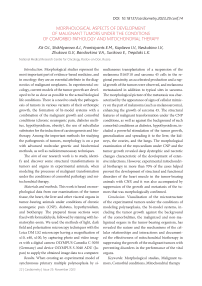Morphological aspects of development of malignant tumors under the conditions of comorbid pathology and mitochondrial therapy
Автор: Kit O.I., Shikhlyarova A.I., Frantsiyants E.M., Kaplieva I.V., Neskubina I.V., Zhukova G.V., Bandovkina V.A., Surikova E., Trepitaki L.K.
Журнал: Cardiometry @cardiometry
Рубрика: Conference proceedings
Статья в выпуске: 29, 2023 года.
Бесплатный доступ
Morphological studies represent the most important part of evidence-based medicine, and in oncology they are an essential attribute in the diagnostics of malignant neoplasms. In experimental oncology, current models of the tumor growth are developed to be as close as possible to the actual biological life conditions. There is a need to study the pathogenesis of tumors in various variants of their orthotopic growth, the formation of bi-model systems with a combination of the malignant growth and comorbid conditions (chronic neurogenic pain, diabetes mellitus, hypothyroidism, obesity), the use of subcellular substrates for the induction of carcinogenesis and biotherapy. Among the important methods for studying the pathogenesis of tumors, morphology is on a par with advanced molecular genetic and biochemical methods, as well as radioimmunoassay techniques.
Morphological studies, malignant tumors, mitochondrial therapy
Короткий адрес: https://sciup.org/148327386
IDR: 148327386 | DOI: 10.18137/cardiometry.2023.29.conf.14
Текст статьи Morphological aspects of development of malignant tumors under the conditions of comorbid pathology and mitochondrial therapy
Introduction . Morphological studies represent the most important part of evidence-based medicine, and in oncology they are an essential attribute in the diagnostics of malignant neoplasms. In experimental oncology, current models of the tumor growth are developed to be as close as possible to the actual biological life conditions. There is a need to study the pathogenesis of tumors in various variants of their orthotopic growth, the formation of bi-model systems with a combination of the malignant growth and comorbid conditions (chronic neurogenic pain, diabetes melli-tus, hypothyroidism, obesity), the use of subcellular substrates for the induction of carcinogenesis and biotherapy. Among the important methods for studying the pathogenesis of tumors, morphology is on a par with advanced molecular genetic and biochemical methods, as well as radioimmunoassay techniques.
multaneous transplantation of a suspension of the melanoma B16/F10 and sarcoma 45 cells in the regional proximity, an accelerated production and a rapid growth of the tumors were observed, and melanoma metastasized in addition to typical sites in sarcoma. The morphological picture of the metastasis was characterized by the appearance of signs of cellular mimicry on the part of melanoma (such as melanosarcoma), enhancing the growth of sarcoma 45. The structural features of malignant transformation under the CNP conditions, as well as against the background of such comorbid conditions as diabetes, hypothyroidism, included a powerful stimulation of the tumor growth, generalization and spreading it to the liver, the kidneys, the ovaries, and the lungs. The morphological examination of the myocardium under CNP and the tumor growth revealed deep dystrophic and necrotic changes characteristic of the development of extensive infarctions. However, experimental mitochondrial biotherapy in more than 70% of the cases helped prevent the development of structural and functional disorders of the heart muscle in the tumor-bearing animals with CNP, and it was also accompanied by suppression of the growth and metastasis of the tumors that was morphologically confirmed.
Conclusion . Visualization of the microstructure of the experimental tumors under the conditions of modeling polyneoplasia, the bi-model systems, including the tumor growth against the background of the comorbidities, the malignized and non-ma-lignized organs in the tumor-bearing organism, has revealed the nature and the mechanisms of the cellular relationships and interactions and documented the effectiveness of mitochondrial biotherapy in suppressing the growth of the malignant tumors with preventing disorders in the performance of the vital organs.


